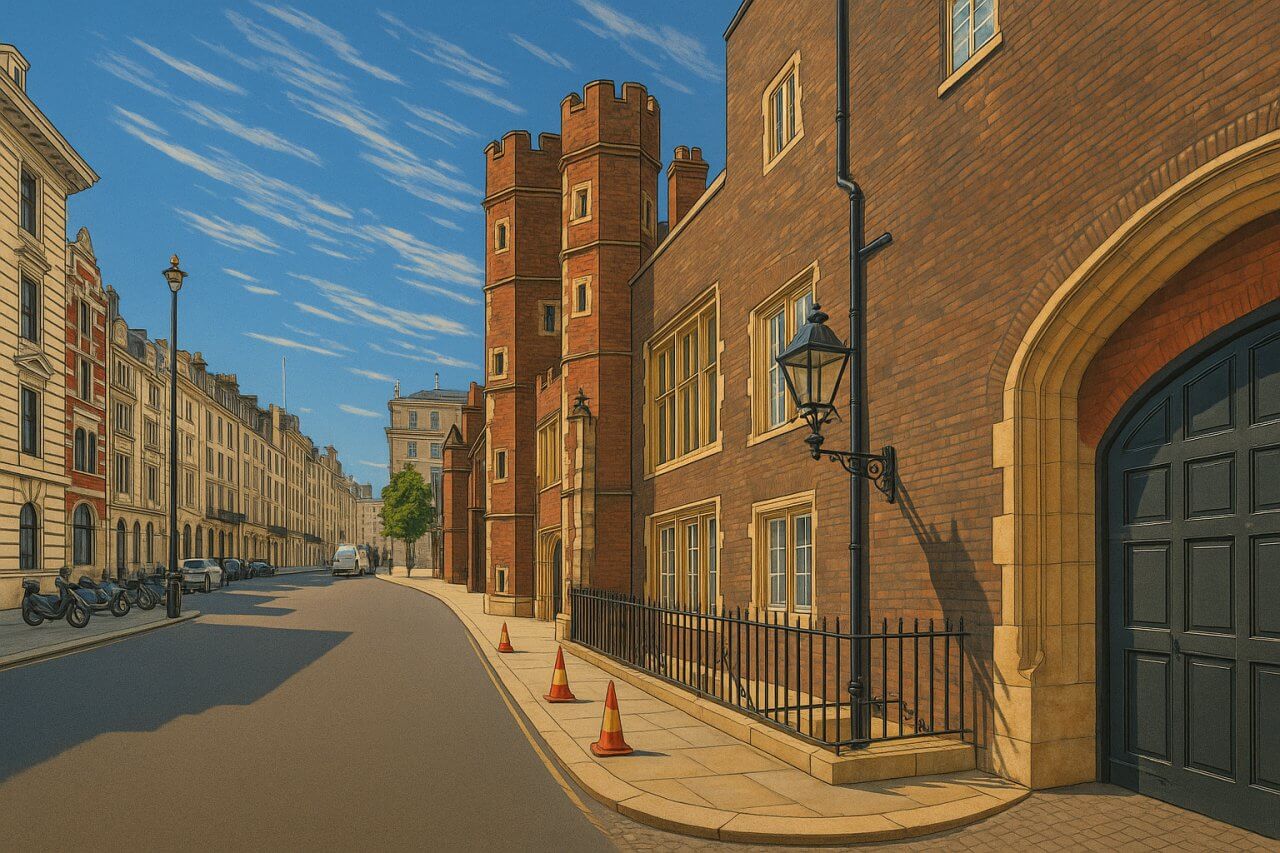
Cleveland Row, London
Cleveland Row is a short, historic street tucked away in the heart of St James’s, City of Westminster. Flanking the northern façade of the imposing St James's Palace, this quiet road offers a glimpse into the ceremonial and aristocratic traditions of central London. Though modest in length, Cleveland Row is steeped in royal and political history and connects seamlessly to the grandeur of Pall Mall and the seclusion of Little St James’s Street and Stable Yard.
Location and Layout
The street runs east-west along the northern boundary of St James’s Palace. On its eastern end, Cleveland Row links directly to Pall Mall at the intersection with St James’s Street, one of London’s most aristocratic roads. The western part of Cleveland Row loops around, providing access to Stable Yard and Little St James’s Street, forming a semi-enclosed enclave behind the palace. In addition, Cleveland Row also branches to a narrow lane called Russell Court.
Cleveland Row is a one-way road, with traffic flowing from the west (Little St James’s Street) toward the east (Pall Mall). This controlled direction helps preserve the quiet, refined nature of the area while facilitating limited vehicle access to the palace and surrounding properties.
History and Etymology
The origins of Cleveland Row date back to the 17th century, a period when the St James’s area was rapidly developing into a prestigious quarter for nobility and royal affiliates. The row formed part of the intricate service network around the Tudor-era St James’s Palace, originally built by Henry VIII in the 1530s.
The street takes its name from Barbara Palmer, Duchess of Cleveland (1640–1709), a prominent mistress of King Charles II. She was granted a nearby residence and wielded significant influence during the Restoration period. The name “Cleveland” is pronounced /'kliːvlənd/  , with a silent ‘a’, much like the American city of the same name. The name spelling remains unchanged since the early 18th century.
, with a silent ‘a’, much like the American city of the same name. The name spelling remains unchanged since the early 18th century.
Character of the Street
Cleveland Row exudes an air of quiet authority and exclusivity. The street is narrow and dignified, lined with red-brick and stone-fronted buildings that echo Georgian and Victorian influences. Owing to its proximity to St James's Palace, much of the street is secured and subject to government or royal oversight, giving it an unusually serene and cloistered feel for central London.
Notable Sights and Buildings
While Cleveland Row itself is short, its surroundings are a treasure trove for history and architecture enthusiasts. Key highlights include:
- St James’s Palace – One of London’s oldest royal residences, the palace’s northern wing borders Cleveland Row.
- Stable Yard – A private courtyard area historically used for royal stables and now for administrative and ceremonial functions.
- Pall Mall – Just to the east, this iconic boulevard is lined with private clubs and royal society buildings.
- St James’s Street – Renowned for gentlemen’s clubs, including White’s and Brooks’s, and heritage tailors.
- Spencer House – A neoclassical mansion nearby, once home to ancestors of Princess Diana, open for public tours on selected days.
Real Estate and Property Information
Property on Cleveland Row is exceptionally rare and almost never changes hands publicly due to its palatial proximity and security restrictions. The few private leases that do exist are priced in line with the St James’s luxury market. As of early 2025, exclusive residences in this area command upwards of £4,500 per sq ft (£48,400 per sq m).1
For example, a 2-bedroom flat measuring 1,200 sq ft (about 111.5 sq m) nearby may fetch between £5.4 million and £6 million, a price significantly higher than the London average of approximately £740 per sq ft (£8,000 per sq m).1 This pricing reflects the area’s prestige and its unparalleled royal adjacency.
Transport Links
Nearest Underground Stations
- Green Park Station (Jubilee, Piccadilly, and Victoria lines) – Approx. 6 minutes’ walk.
- St James’s Park Station (Circle and District lines) – Approx. 10 minutes’ walk.
- Piccadilly Circus Station – Also within easy walking distance, offering access to Bakerloo and Piccadilly lines.
Nearby Bus Stops
- Pall Mall / St James’s Palace stop – Just east of Cleveland Row, served by buses 9, 14, 19, 22, and 38.
- St James’s Street stop – Additional routes including night buses and 24-hour services.
Fun Fact
In the 1970s, Cleveland Row and its surroundings were featured in espionage thrillers and political dramas due to their proximity to Clubland and Whitehall. The secluded lanes behind St James’s Palace were portrayed as ideal locales for clandestine meetings and secret liaisons.
Quick Facts
- Location: St James’s, City of Westminster, London
- Length: Approx. 150 metres (492 feet)
- Traffic: One-way, west to east
- Origin: 17th century, near St James's Palace
- Name Origin: Named after Barbara Palmer, Duchess of Cleveland
- Pronunciation: 'Cleveland' – /ˈkliːvlənd/
- Nearby Sights: St James's Palace, Pall Mall, Spencer House, St James's Street
- Real Estate: £4,500 per sq ft (£48,400 per sq m), as of 2025
- Nearest Stations: Green Park, St James's Park, Piccadilly Circus
- Bus Routes: 9, 14, 19, 22, 38 via Pall Mall
- Fun Fact: Featured in Cold War era spy novels and dramas
References
Map of Cleveland Row, London

Painting of Cleveland Row, London (View image in full size)